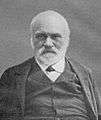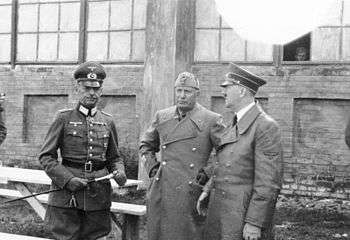Alpine race
The Alpine race is a historical race concept defined by some late 19th-century and early 20th-century anthropologists as one of the sub-races of the Caucasian race.[1][2][3] The origin of the Alpine race was variously identified. Ripley argued that it migrated from Central Asia during the Neolithic revolution, splitting the Nordic and Mediterranean populations. It was also identified as descending from the Celts residing in Central Europe in Neolithic times.[4] The Alpine race is mainly distinguished by its cranial measurements, such as high cephalic index.
History
The term "Alpine" (H. Alpinus) has historically been given to denote a physical type within the Caucasian race, first defined by William Z. Ripley (1899), but originally proposed by Vacher de Lapouge. It is equivalent to Joseph Deniker's "Occidental" or "Cevenole" subrace[5][6] and Jan Czekanowski identified it, as of the Lappanoid race which means that Alpines are a mixture of Lappanoid and Armenoid. In the early 20th century the Alpine physical type was popularised by numerous anthropologists, such as Thomas Griffith Taylor and Madison Grant, as well as in Soviet era anthropology.[7][8] The Homo Alpinus was first proposed by the French raciologist Georges Vacher de Lapouge, but Chanda picked it up through the writings of T. A. Joyce. 37 Like Sur, Chanda had denied any direct relationship between Bengali upper castes and north Indian upper castes. 38 Yet, this did not mean that the Bengali upper castes were autochthons; they were merely descended from a separate branch of the Aryan family tree, namely, the Homo Alpinus.
The German Nazi Party under the influence direction of Hans F. K. Günther, recognized the Germans as including five Aryan racial subtypes, described by Günther in his work Kleine Rassenkunde des deutschen Volkes (1929): Nordic, Alpine, Mediterranean, East Baltic, and Dinaric, viewing Nordics as being at the top of the racial hierarchy.[1] He defined each racial subtype according to general physical appearance and their psychological qualities including their "racial soul" - referring to their emotional traits and religious beliefs, and provided detailed information on their hair, eye, and skin colours, facial structure.[1] He provided photographs of Germans identified as Nordic in places like Baden, Stuttgart, Salzburg, and Swabia; and provided photographs of Germans he identified as Nordic and Mediterranean types, especially in Bavaria and the Black Forest region of Baden.[1] Hitler was so impressed by this work by Günther, that he made it the basis of his eugenics policy.[1]
Adolf Hitler utilized the term Alpine to refer to a type of the Aryan race, and in an interview spoke admiringly about his idol Italian Fascist leader Benito Mussolini, commending Mussolini's Alpine racial heritage saying:
They know that Benito Mussolini is constructing a colossal empire which will put the Roman Empire in the shade. We shall put up ... for his victories. Mussolini is a typical representative of our Alpine race...
— Adolf Hitler, 1931[9]
It however fell out of popularity by the 1950s, but reappeared in the literature of Sonia Mary Cole (1963) and Carleton Coon (1969).[10] In more recent sources, a small array of anthropologists accustomed with such usage, still use the term.[11]
Physical appearance
A typical Alpine skull is regarded as brachycephalic ('broad-headed'), but may be within the mesocephalic range as well.[12] As well as being broad in the crania, this thickness appears generally elsewhere in the morphology of the Alpine, as Hans Günther describes:
...the Alpine race is thick-set and broad. The average height of the Alpine man is about 1.63 metres. This small height is brought about by the relatively short, squat legs. This broadness and shortness is repeated in all the details: in the broadness of the hand and its short fingers, in the short, broad feet, in the thick, short calves.
 Henry Keane's Man, Past and Present (1899) shows a Tajik as an example of the Alpine type
Henry Keane's Man, Past and Present (1899) shows a Tajik as an example of the Alpine type- An Italian from the Piedmont - of the Alpine (Alpinoid) type
 Meyers Blitz-Lexikon (Leipzig, 1932) shows the German cartographer Heinrich Kiepert as an example of the Alpine type
Meyers Blitz-Lexikon (Leipzig, 1932) shows the German cartographer Heinrich Kiepert as an example of the Alpine type- A Frenchman from the Auvergne - of the Alpine (Alpinoid) type
Ripley (1899) further notes that the nose of the Alpine is broader (mesorrhine) while their hair is usually a chestnut colour and their occiputs are slightly rounded. According to Robert Bennett Bean (1932) the skin pigmentation of the Alpine is an 'intermediate white', a colour in-between the lighter skinned Nordic and the darker-skinned Mediterranean.[13] Despite the large numbers of alleged Alpines, the characteristics of the Alpines were not as widely discussed as those of the Nordics and Mediterraneans. Typically they were portrayed as "sedentary": solid peasant stock, the reliable backbone of the European population, but not outstanding for qualities of leadership or creativity. Madison Grant insisted on their "essentially peasant character".[14]
Geography and origin
According to Ripley and Coon, the Alpine race is predominant in Central Europe and parts of Western/Central Asia. Ripley argued that the Alpines had originated in Asia, and had spread westwards along with the emergence and expansion of agriculture, which they established in Europe. By migrating into Central Europe, they had separated the northern and southern branches of the earlier European stock, creating the conditions for the separate evolution of Nordics and Mediterraneans. This model was repeated in Madison Grant's book The Passing of the Great Race (1916), in which the Alpines were portrayed as the most populous of European and western Asian races. However, in Carleton Coon's rewrite of Ripley's The Races of Europe, he developed a different argument that they reduced the Upper Paleolithic survivors indigenous to Europe, based on prehistoric broad-headed crania unearthed at Grenelle, France, and the findings at Furfooz in the Belgian province of Namur:
...Alpine: A reduced and somewhat foetalized survivor of the Upper Palaeolithic population in Late Pleistocene France, highly brachycephalized; seems to represent in a large measure the bearer of the brachycephalic factor in Crô-Magnon. Close approximations to this type appear also in the Balkans and in the highlands of western and central Asia, suggesting that its ancestral prototype was widespread in Late Pleistocene times. In modern races it sometimes appears in a relatively pure form, sometimes as an element in mixed brachycephalic populations of multiple origin. It may have served in both Pleistocene and modern times as a bearer of the tendency toward brachycephalization into various population.
Coon further argued that they were linked to their unreduced (Brünn, Borreby) counterparts.
A debate concerning the origin of the Alpine race in Europe, involving Arthur Keith, John Myres and Alfred Cort Haddon was published by the Royal Geographical Society in 1906.[15]
Despite the large numbers of this alleged race, the characteristics of the Alpines were not as widely discussed and disputed as those of the Nordics and Mediterraneans. Typically they were portrayed as "sedentary": solid peasant stock, the reliable backbone of the European population, but not outstanding for qualities of leadership or creativity. Madison Grant insisted on their "essentially peasant character".[14]
See also
References
- 1 2 3 4 5 Anne Maxwell, Picture Imperfect: Photography and Eugenics, 1870–1940, Sussex Academic Press, 2010, ISBN 1845194152
- ↑ Race and Racism: An Introduction (see also) by Carolyn Fluehr-Lobban, Pages 127-133, Publication Date: December 8, 2005, ISBN 0759107955
- ↑ The Races of Europe by Carleton S. Coon
- ↑ J. A. MacCulloch. Religion of the Ancient Celts. Kessinger Publishing, 2003. P. 8.
- ↑ Les Six Races Composant la Population Actuelle de l'Europe, J. Deniker, The Journal of the Anthropological Institute of Great Britain and Ireland, Vol. 34, (Jul. - Dec., 1904), pp. 181-206.
- ↑ Deniker's Classification of the Races of Europe, William Z. Ripley, The Journal of the Anthropological Institute of Great Britain and Ireland, Vol. 28, No. 1/2 (1899), pp. 166-173.
- ↑ The Nordic and Alpine Races and Their Kin: A Study of Ethnological Trends, Griffith Taylor, American Journal of Sociology, Vol. 37, No. 1 (Jul., 1931), pp. 67-81.
- ↑ The Great Soviet Encyclopaedia (Russian)
- ↑ Richard Breiting, Adolf Hitler, Édouard Calic (ed.). Secret conversations with Hitler:the two newly-discovered 1931 interviews. John Day Co., 1971. P. 77.
- ↑ Carleton Stevens Coon, Edward E. Hunt, The living races of man, Knopf, 1969, p. 66.
- ↑ Roger Pearson, Anthropological Glossary, Krieger Publishing Co., Malabar, Fl. 1985. Alice Mossie Brues, People and Races, 1990.
- ↑ The Alpine Races in Europe , John L. Myres, The Geographical Journal, Vol. 28, No. 6 (Dec., 1906), pp. 537-553.
- ↑ The Races of Man. Differentiation and Dispersal of Man, p. 32.
- 1 2 Grant, Madison, The Passing of the Great Race, 1916, part 2, ch. 11; part 2, chapter 5.
- ↑ The Alpine Races in Europe: Discussion, D. G. Hogarth, Arthur Evans, Dr. Haddon, Dr. Shrubsall, Mr. Hudleston, Mr. Gray, Dr. Wright and Mr. Myres, The Geographical Journal, Vol. 28, No. 6 (Dec., 1906) (pp. 553-560).
Further reading
- Spiro, Jonathan P. (2009). Defending the Master Race: Conservation, Eugenics, and the Legacy of Madison Grant. Univ. of Vermont Press. ISBN 978-1-58465-715-6. Lay summary (29 September 2010).
